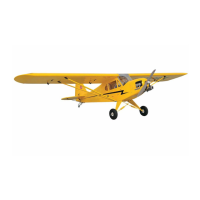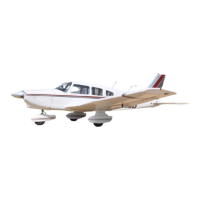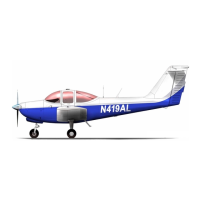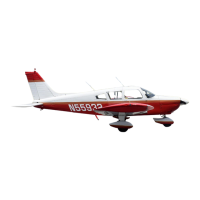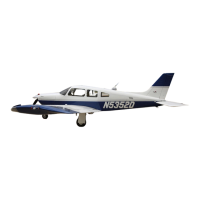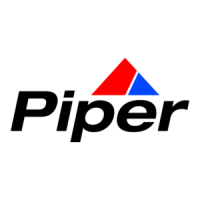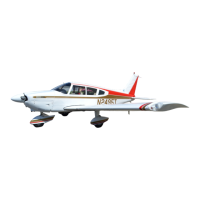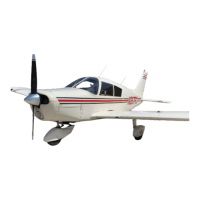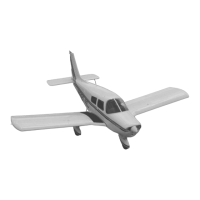Do you have a question about the Piper J3C-65 and is the answer not in the manual?
Details on fabric-covered wing construction, including spar types, fabric, and drain grommets.
Explains drag bracing using steel struts and wires, emphasizing inspection for looseness and corrosion.
Describes the leading edge construction using formed aluminum alloy sheets and attachment methods.
Details the construction of the wing tip bow, its attachment to spars, and stiffeners.
Describes the aileron false spar, its material, attachment to ribs, and inspection for corrosion.
Details the fabrication of aileron hinge brackets from steel tubes and fittings, and inspection requirements.
Explains spar strut and wing hinge fittings, their materials, attachment, and inspection for corrosion.
Describes lift strut construction, attachment to wing and fuselage, and inspection for wear and looseness.
Steps for raising the aircraft and placing jacks for rigging, including tail positioning.
Procedures for achieving lateral and longitudinal level flight position for rigging adjustments.
Method for checking wing dihedral angle using a string and measuring distance to the center section.
Procedure for adjusting wing wash out using a level and spacer blocks on the rear spar.
Procedures for leveling stabilizers, adjusting brace wires, and plumbing the fin for the tail assembly.
Details the main gear, sprung wheels, low-pressure tires, and hydraulic brakes of the chassis.
Information on tire size, recommended pressure, installation, and wear equalization for longevity.
Describes cast aluminum wheels with tapered roller bearings, lubrication, and preventing end play.
Details the dual hydraulic wheel brake system, pedal mounting, and hydraulic units.
Maintenance for landing gear hinge fittings, lubrication, wear checks, and replacement of bolts.
Description of the standard steerable tail wheel with a solid rubber tire.
Details the fuselage frame construction using welded steel tubing, including material types for stressed members.
Description of the engine mount construction and maintenance, including bolt checks and replacement of cracked mounts.
Details aileron structure, materials, spar, ribs, hinges, and maintenance including lubrication.
Describes the vertical fin structure, material, and attachment to the fuselage.
Information on rudder construction and maintenance, emphasizing corrosion inspection and hinge lubrication.
Describes stabilizer frame, adjustment mechanism via screw and cable, and tie rod bracing.
Information on elevator structure similarity to the rudder, maintenance, and drain grommets.
Details the control stick linkage to elevators, including push-pull tubes, bellcranks, and turnbuckles.
Explains lateral control linkage to ailerons, cables, pulleys, and the procedure for rigging ailerons.
Describes the rudder control system, inspection of cables, pedals, and tail wheel connectors.
Explains the stabilizer adjustment mechanism using a crank, cable, pulley, and screw for incidence control.
Details the fuel tank location, capacity, support straps, and procedure for its removal.
Describes the engine primer, its fuel line connections, and recommendations for its use.
Explains the carburetor heater, its control, function for preventing icing, and precautions for hot weather.
Details fuel strainer location, daily inspection for water/sediment, and cleaning procedures.
Describes the location of the fuel tank drain and the need for periodic removal of water and sediment.
Explains the finger strainer in the fuel tank outlet, its purpose, and cleaning schedule.
Notes that an electrical system is not standard, but the panel has provisions for navigation lights.
Describes the ignition system components, magnetos, and switch location.
Checklist for pre-flight line inspections, covering engine mount, controls, fuel, and covering.
Inspection items for 20-hour intervals, including items from line inspection, drain plug, and lubrication.
Details requirements for 100-hour periodic inspections for both commercial and private aircraft owners.
Pre-flight checks including fuel supply, oil level, control movement, and general aircraft condition.
Step-by-step procedure for starting the engine, including safety precautions and troubleshooting.
Guidelines for warming up the engine, checking oil pressure, and magneto checks.
Procedures for stopping the engine, including gradual cooling and checking carburetor heat.
Instructions for taxiing, controlling direction with rudder, and managing ground speed.
Advice on takeoff speed, climb speed, cruising RPM, and safe diving speeds.
Guidance on approach speeds, glide speeds, and engine clearing during landing.
Procedures for parking, mooring with ropes, and securing controls in windy conditions.
Explains load factor as the ratio of airload on the wing to gross weight, defining its significance.
Discusses how maneuvers like pulling back on the stick increase angle of attack and create load factors.
Explains load factors in banked turns, the effect of slips and skids, and limits for safe banking.
Provides a table of minimum speeds required for safe banked turns based on wing angle and stalling speed.
Recommendations for the initial 25 hours of operation, focusing on engine RPM and warm-up procedures.
Specifies minimum octane for gasoline and recommends aviation-grade oil based on outside air temperature.
Emphasizes frequent washing, especially after muddy operations, and the importance of cleanliness for fabric care.
Advice on keeping drain grommets open, repairing fabric, checking sheet metal screws, and tail wheel security.
Guidelines for ground handling, avoiding damage to wings, struts, stabilizers, and landing gear.
Emphasizes checking fuel supply before becoming airborne to avoid forced landings.
Advises against careless taxiing, recommending slow speeds and proper control use in wind.
Stresses the importance of following air traffic rules and maintaining lookout for other aircraft.
Warns against flat turns, particularly during power-off turns, emphasizing aileron control.
Advises maintaining sufficient airspeed, warning against ground speed illusions from downwind turns.
Cautioning against attempting maneuvers beyond one's ability or training, like instrument flying.
Recommends using the carburetor heater to prevent ice formation, which is easier than eliminating it.
Warns against performing aerobatics at low altitudes due to the severe risks involved.
Stresses the importance of decisive judgment and avoiding errors, as indecision can be fatal.
States that a good pilot is a safe pilot, prioritizing safety over boldness.
Details on fabric-covered wing construction, including spar types, fabric, and drain grommets.
Explains drag bracing using steel struts and wires, emphasizing inspection for looseness and corrosion.
Describes the leading edge construction using formed aluminum alloy sheets and attachment methods.
Details the construction of the wing tip bow, its attachment to spars, and stiffeners.
Describes the aileron false spar, its material, attachment to ribs, and inspection for corrosion.
Details the fabrication of aileron hinge brackets from steel tubes and fittings, and inspection requirements.
Explains spar strut and wing hinge fittings, their materials, attachment, and inspection for corrosion.
Describes lift strut construction, attachment to wing and fuselage, and inspection for wear and looseness.
Steps for raising the aircraft and placing jacks for rigging, including tail positioning.
Procedures for achieving lateral and longitudinal level flight position for rigging adjustments.
Method for checking wing dihedral angle using a string and measuring distance to the center section.
Procedure for adjusting wing wash out using a level and spacer blocks on the rear spar.
Procedures for leveling stabilizers, adjusting brace wires, and plumbing the fin for the tail assembly.
Details the main gear, sprung wheels, low-pressure tires, and hydraulic brakes of the chassis.
Information on tire size, recommended pressure, installation, and wear equalization for longevity.
Describes cast aluminum wheels with tapered roller bearings, lubrication, and preventing end play.
Details the dual hydraulic wheel brake system, pedal mounting, and hydraulic units.
Maintenance for landing gear hinge fittings, lubrication, wear checks, and replacement of bolts.
Description of the standard steerable tail wheel with a solid rubber tire.
Details the fuselage frame construction using welded steel tubing, including material types for stressed members.
Description of the engine mount construction and maintenance, including bolt checks and replacement of cracked mounts.
Details aileron structure, materials, spar, ribs, hinges, and maintenance including lubrication.
Describes the vertical fin structure, material, and attachment to the fuselage.
Information on rudder construction and maintenance, emphasizing corrosion inspection and hinge lubrication.
Describes stabilizer frame, adjustment mechanism via screw and cable, and tie rod bracing.
Information on elevator structure similarity to the rudder, maintenance, and drain grommets.
Details the control stick linkage to elevators, including push-pull tubes, bellcranks, and turnbuckles.
Explains lateral control linkage to ailerons, cables, pulleys, and the procedure for rigging ailerons.
Describes the rudder control system, inspection of cables, pedals, and tail wheel connectors.
Explains the stabilizer adjustment mechanism using a crank, cable, pulley, and screw for incidence control.
Details the fuel tank location, capacity, support straps, and procedure for its removal.
Describes the engine primer, its fuel line connections, and recommendations for its use.
Explains the carburetor heater, its control, function for preventing icing, and precautions for hot weather.
Details fuel strainer location, daily inspection for water/sediment, and cleaning procedures.
Describes the location of the fuel tank drain and the need for periodic removal of water and sediment.
Explains the finger strainer in the fuel tank outlet, its purpose, and cleaning schedule.
Notes that an electrical system is not standard, but the panel has provisions for navigation lights.
Describes the ignition system components, magnetos, and switch location.
Checklist for pre-flight line inspections, covering engine mount, controls, fuel, and covering.
Inspection items for 20-hour intervals, including items from line inspection, drain plug, and lubrication.
Details requirements for 100-hour periodic inspections for both commercial and private aircraft owners.
Pre-flight checks including fuel supply, oil level, control movement, and general aircraft condition.
Step-by-step procedure for starting the engine, including safety precautions and troubleshooting.
Guidelines for warming up the engine, checking oil pressure, and magneto checks.
Procedures for stopping the engine, including gradual cooling and checking carburetor heat.
Instructions for taxiing, controlling direction with rudder, and managing ground speed.
Advice on takeoff speed, climb speed, cruising RPM, and safe diving speeds.
Guidance on approach speeds, glide speeds, and engine clearing during landing.
Procedures for parking, mooring with ropes, and securing controls in windy conditions.
Explains load factor as the ratio of airload on the wing to gross weight, defining its significance.
Discusses how maneuvers like pulling back on the stick increase angle of attack and create load factors.
Explains load factors in banked turns, the effect of slips and skids, and limits for safe banking.
Provides a table of minimum speeds required for safe banked turns based on wing angle and stalling speed.
Recommendations for the initial 25 hours of operation, focusing on engine RPM and warm-up procedures.
Specifies minimum octane for gasoline and recommends aviation-grade oil based on outside air temperature.
Emphasizes frequent washing, especially after muddy operations, and the importance of cleanliness for fabric care.
Advice on keeping drain grommets open, repairing fabric, checking sheet metal screws, and tail wheel security.
Guidelines for ground handling, avoiding damage to wings, struts, stabilizers, and landing gear.
Emphasizes checking fuel supply before becoming airborne to avoid forced landings.
Advises against careless taxiing, recommending slow speeds and proper control use in wind.
Stresses the importance of following air traffic rules and maintaining lookout for other aircraft.
Warns against flat turns, particularly during power-off turns, emphasizing aileron control.
Advises maintaining sufficient airspeed, warning against ground speed illusions from downwind turns.
Cautioning against attempting maneuvers beyond one's ability or training, like instrument flying.
Recommends using the carburetor heater to prevent ice formation, which is easier than eliminating it.
Warns against performing aerobatics at low altitudes due to the severe risks involved.
Stresses the importance of decisive judgment and avoiding errors, as indecision can be fatal.
States that a good pilot is a safe pilot, prioritizing safety over boldness.
| Manufacturer | Piper Aircraft |
|---|---|
| Model | J3C-65 |
| Type | Light Aircraft |
| Horsepower | 65 hp |
| Maximum Takeoff Weight | 1, 220 lb (553 kg) |
| Crew | 1 |
| Capacity | 1 passenger |
| Engine | Continental A65 |
| Wingspan | 10.8 m |
| Height | 2.0 m |
| Empty Weight | 740 lb |
| Fuel Capacity | 12 US gal (45 L) |
| Cruise Speed | 75 mph (121 km/h) |
| Maximum Speed | 87 mph (140 km/h) |
| Stall Speed | 38 mph (61 km/h) |
| Length | 22 ft 5 in (6.83 m) |
